You have no items in your shopping cart.
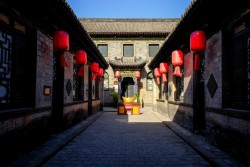

Introducing Taiyuan Jinci Temple
Jinci Temple can be traced back to the Western Zhou Dynasty between 1046 BC and 711 BC, when King Cheng enfeoffed his brother Shu Yu as the ruler of a vassal state in today's Shanxi province. Jinci Temple was built to honor Shu Yu who founded the Jin state. The cypress trees to the north of the Hall of the Holy Mother were supposedly planted by Shu Yu himself somewhat 3000 years ago. It was clearly recorded in history that Shu Yu Memorial Temple, the ancient name of Jinci Temple, existed in the current location during the Northern Wei Dynasty (368-534). Modified and expanded during the Sui, Tang, Song, Yuan, Ming, and Qing Dynasties, the resulting Jinci Temple is a diverse collection of buildings in a variety of architectural styles. Today Jinci Temple comprises of over 100 halls, towers, pavilions, terraces, and bridges, among which the Hall of the Holy Mother built in the Song Dynasty, the Hall of Offerings, the Flying Bridge across the Fish Ponds are identified by China's Ministry of Culture as three national treasures of China.
Watch this video showcasing Taiyuan Jinci Temple
Kind Notice: You can not watch this video if you are in China (YouTube is blocked in China).
Taiyuan Jinci Temple Fast Facts
• Chinese Name: Jin Ci 晋祠
• Best Time to Visit: April to Oct
• Recommended Visiting Hours: 2 -3 hours
• Things to Do: Architecture, sculptures
• Opening Hours: 08:00 to 18:00 from Apr to Oct; 08:00 to 17:30 from Nov to Mar
• Entrance Fee: CNY80 from Apr to Oct; CNY65 from Nov to Mar
• Address: Jingci Town, Jinyuan District, Taiyuan, Shanxi Province
Why visit Taiyuan Jinci Temple
Taiyuan Jinci Temple includes some of the best Song Dynasty sculptures and buildings still extant in China. Well known structures at Jinci Temple include the Hall of Offerings, The Flying Bridge across the Fish Pond, and the Hall of the Holy Mother, the most famous building at Jinci Temple. Completed in 1032 and with carved wooden dragons coiled around the eight pillars that support its upward-curving double-eave hip-and-gable roof, this impressive structure contains some of the finest Song Dynasty clay sculptures in China, each with a different facial expression.
What to expect at Taiyuan Jinci Temple
The beauty of Jinci Temple is that it completely reserved the characteristic and appearance of an ancient architecture without adding any modern factor. The main buildings are distributed along the central axis from east to west. They are the Mirror Terrace, the Iron Men Terrace, Duiyue Archway, the Hall of Offerings, the Flying Bridge across the Fish Ponds, and the Hall of the Holy Mother respectively.
The Mirror Terrace
The mirror terrace was first built in the Ming Dynasty (1368-1644) as a stage for performing local opera in tradition festivals. The front part of the Mirror Terrace has single-eaved round ridge roof while the back part is double-eaved hip-and-gable roof. Every part of its columns and beams were skillfully carved with beautiful designs in colors. The excessive carvings at pillars, columns and cross beams of Mirror Terrace though had been restored, they were still extra-ordinary. There are two temple fairs here at Jinci Temple, one is on June 15 and one is on July 2. Local Shanxi operas will be performed at the Mirror Terrace during the annual temple fairs.
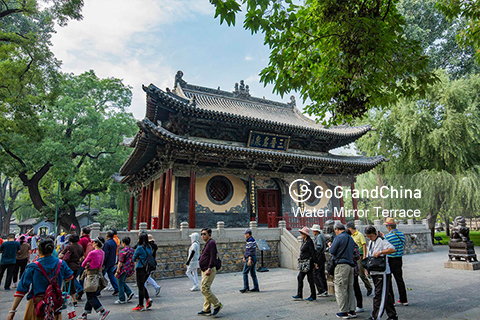
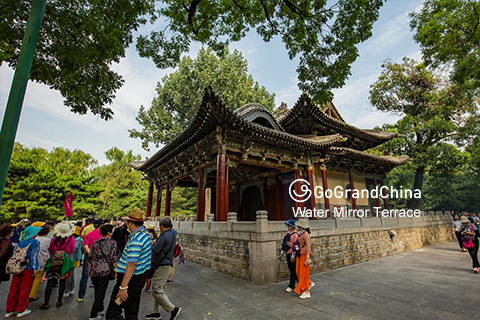
The Iron Men Terrace
A 4 meter high Ming Dynasty (1368-1644) glazed furnace is in the center of the Iron Men Terrace. Four iron men who are 2 meter tall are standing at four corners, in which one was destroyed in war and re-cast in year 1913. The other three were all remained from Song Dynasty (960-1279). The one standing at south west was especially outstanding. The epigraph on his chest reads: cast in the 4th year (1097) of the Shaosheng reign of the Northern Song Dynasty (1127-1279). These iron men were placed here in the hope to avoid floods and regarded as water guardians. They are master piece from the high development of iron casting technology of the Song Dynasty.
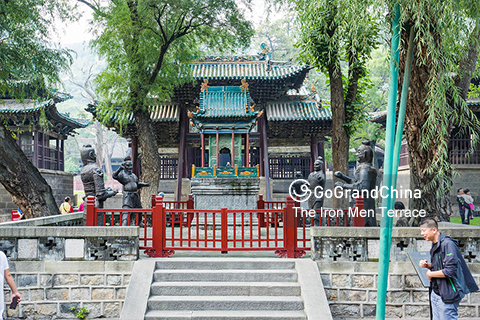
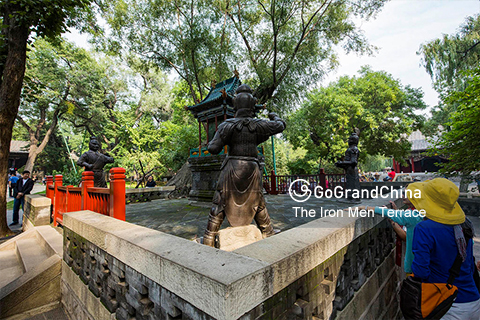
Duiyue Archway
Duiyue Archway was built in year 1576 during Ming Dynasty. The two Chinese characters Dui (对) and Yue (越) were abstracted from The Book of Songs, one of the traditional Confucian classics, which means to appreciate and praise for the great love of mothers. Right here, mothers love was in reference to the merit and virtue of the holy mother. Duiyue Archway is flanked by Bell Tower to its right and Drum Tower to its left.
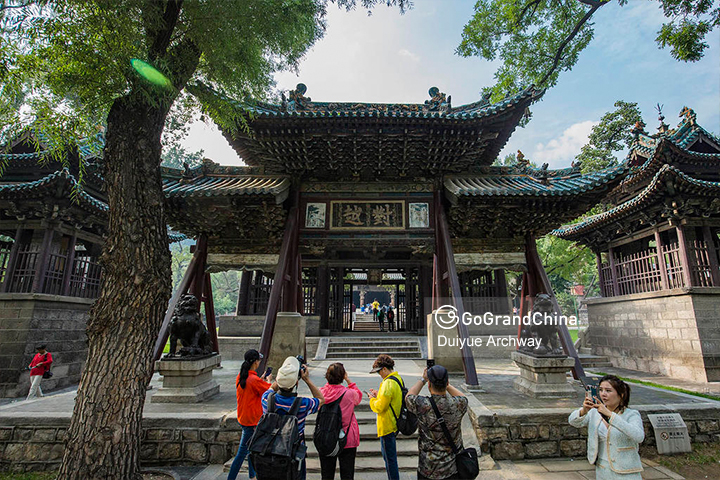
The Hall of Offerings
The Hall of Offerings with single-eaved hip-and-gable roof was first built in 1168 during the Jin Dynasty (1115-1234) where offerings were made to the Holy Mother. The last restoration was done in 1995 with the same material. It retained the architectural characteristics of the Jin Dynasty and is one of the three nationally treasured architectures of Jinci Temple and the treasure of China's ancient buildings.
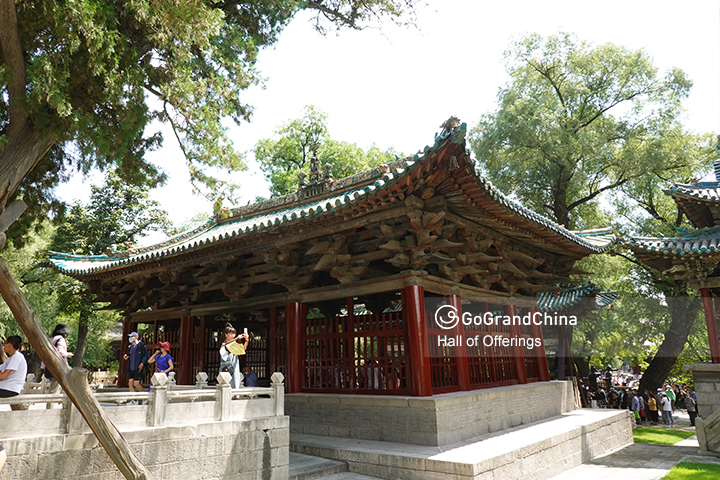
The Flying Bridge across the Fish Ponds
The Flying Bridge over the Fish Ponds was built in the same time as The Hall of Holy Mother in Song Dynasty to connect the Hall of Holy Mother to The Hall of Offerings on the opposite side. It was supported by 34 octagonal stone pillars with a lotus flower shaped base erected under the water. On top of the pillars are wooden joints. The bridge looks just like a huge bird ready to fly, hence the name Feiliang (flying girder). The Bridge is the only one of its kind that exists now in China, it is one of the three national treasured structures of Jinci Temple.
The Hall of the Holy Mother
The Hall of the Holy Mother is final building on the central axis of Jinci Temple. It was built in 984 during the Song Dynasty (960-1127) and restored several times after that. The original architectural style and design was completely maintained and reserved during its most recent restoration in the Ming Dynasty (1368-1644). It is a grand structure decorated with yellow and green glazed edgework and carved wooden dragons coiled around its eight supporting pillars of its double-eave hip-and-gable roof. This is one of the earliest surviving wooden building structures in China. The Holy Mother enshrined in the center of this hall is Yi Jiang, the mother of Jin's founder, Shu Yu and King Cheng of the Zhou Dynasty, the wife of King Wu of Zhou Dynasty and the daughter of the famous general of Zhou Dynasty, Jiang Ziya. Sitting in a lotus position in a wooden carved altar, the Holy Mother is accompanied by 42 life-size sculptures of attendants, all sculpted during Song Dynasty in a vivid and natural way, especially the 33 figures of maidservants. Each figure was unique with various pose, vivid facial expression, and in perfect proportion. They truly revealed the daily activities of a palace life in Song Dynasty. These figures were the master piece of Song Color clay sculpture arts and had special position in the sculpture arts of ancient China.
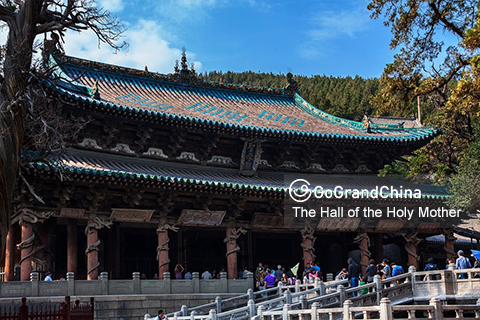
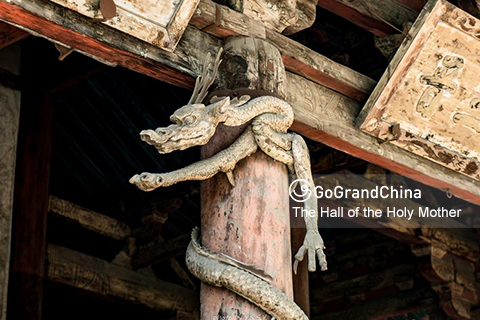
The Never Aging Spring
The Never Aging Spring is located to the south of the Hall of the Holy Mother and it is the third wonder of Jinci Temple. The Spring Pavilion was built in the Tianbao reign (550-559) of the Northern Qi Dynasty but restored in Ming Dynasty during years 1552-1567. Nevertheless, the style of this pavilion structure that was constructed over spring water was still maintained as it was in the Northern Qi Dynasty. The pavilion is octagonal with a pyramidal roof. The name of Never Aging Spring was abstracted from The Book of Songs, one of the traditional Confucian classics, which means never getting old is forever gifted. It is so named because water continuously flows out from the well under the pavilion, never ceased. The spring is one of the main water sources of Jin River.
How to get to Jinci Temple
• Jinci Temple is approximately 25km away from Taiyuan.
• Jinci Temple can be reached by local bus 308, 79, 301, 319, 804, and 856.
• Rent a car/bus from GGC to enjoy a hassle free private transfer from hotels in Taiyuan to Jinci Temple.